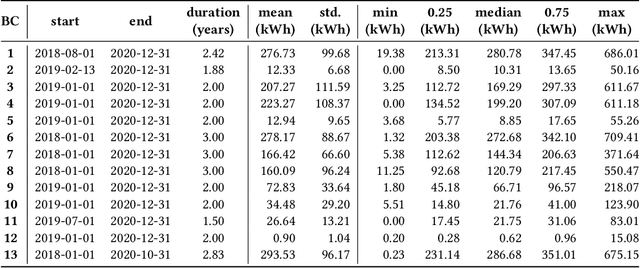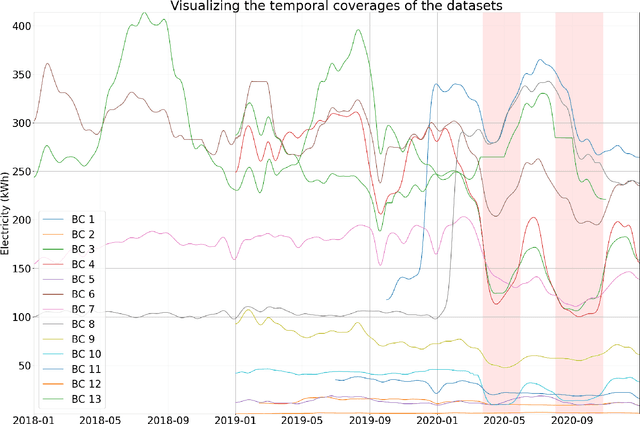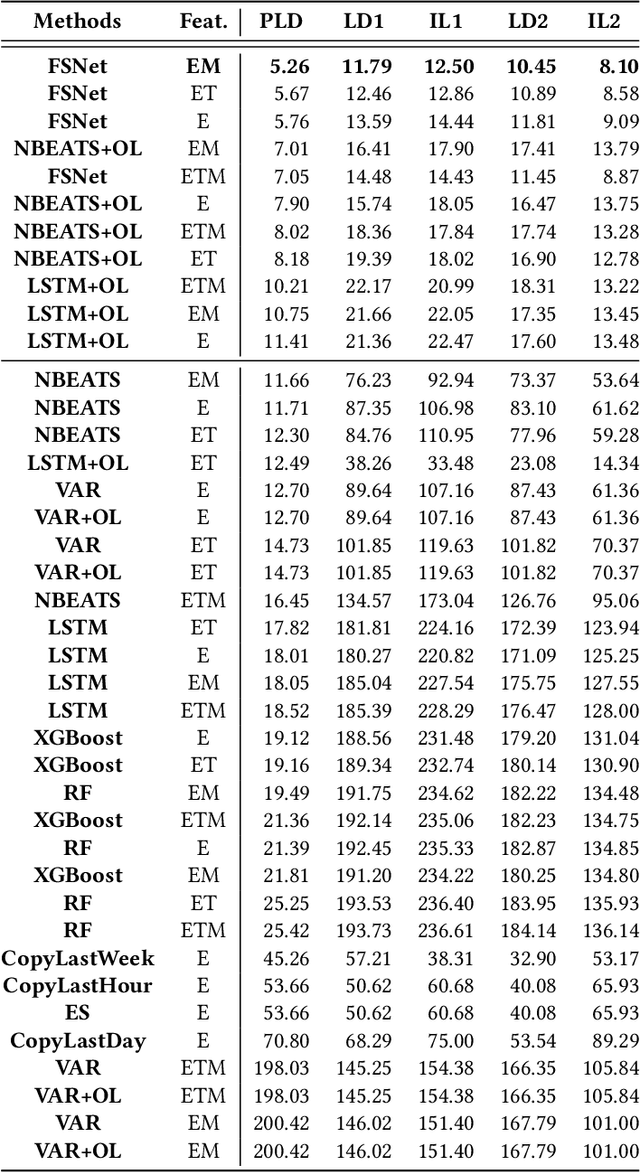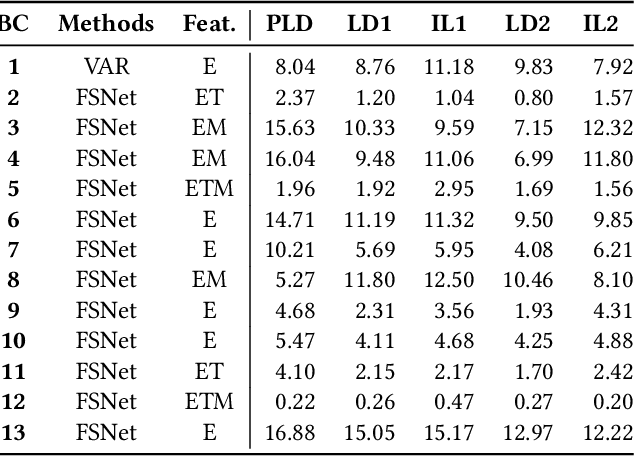Arian Prabowo
Embedding spatial context in urban traffic forecasting with contrastive pre-training
Mar 19, 2025Abstract:Urban traffic forecasting is a commonly encountered problem, with wide-ranging applications in fields such as urban planning, civil engineering and transport. In this paper, we study the enhancement of traffic forecasting with pre-training, focusing on spatio-temporal graph methods. While various machine learning methods to solve traffic forecasting problems have been explored and extensively studied, there is a gap of a more contextual approach: studying how relevant non-traffic data can improve prediction performance on traffic forecasting problems. We call this data spatial context. We introduce a novel method of combining road and traffic information through the notion of a traffic quotient graph, a quotient graph formed from road geometry and traffic sensors. We also define a way to encode this relationship in the form of a geometric encoder, pre-trained using contrastive learning methods and enhanced with OpenStreetMap data. We introduce and discuss ways to integrate this geometric encoder with existing graph neural network (GNN)-based traffic forecasting models, using a contrastive pre-training paradigm. We demonstrate the potential for this hybrid model to improve generalisation and performance with zero additional traffic data. Code for this paper is available at https://github.com/mattchrlw/forecasting-on-new-roads.
XXLTraffic: Expanding and Extremely Long Traffic Dataset for Ultra-Dynamic Forecasting Challenges
Jun 18, 2024Abstract:Traffic forecasting is crucial for smart cities and intelligent transportation initiatives, where deep learning has made significant progress in modeling complex spatio-temporal patterns in recent years. However, current public datasets have limitations in reflecting the ultra-dynamic nature of real-world scenarios, characterized by continuously evolving infrastructures, varying temporal distributions, and temporal gaps due to sensor downtimes or changes in traffic patterns. These limitations inevitably restrict the practical applicability of existing traffic forecasting datasets. To bridge this gap, we present XXLTraffic, the largest available public traffic dataset with the longest timespan and increasing number of sensor nodes over the multiple years observed in the data, curated to support research in ultra-dynamic forecasting. Our benchmark includes both typical time-series forecasting settings with hourly and daily aggregated data and novel configurations that introduce gaps and down-sample the training size to better simulate practical constraints. We anticipate the new XXLTraffic will provide a fresh perspective for the time-series and traffic forecasting communities. It would also offer a robust platform for developing and evaluating models designed to tackle ultra-dynamic and extremely long forecasting problems. Our dataset supplements existing spatio-temporal data resources and leads to new research directions in this domain.
BTS: Building Timeseries Dataset: Empowering Large-Scale Building Analytics
Jun 18, 2024Abstract:Buildings play a crucial role in human well-being, influencing occupant comfort, health, and safety. Additionally, they contribute significantly to global energy consumption, accounting for one-third of total energy usage, and carbon emissions. Optimizing building performance presents a vital opportunity to combat climate change and promote human flourishing. However, research in building analytics has been hampered by the lack of accessible, available, and comprehensive real-world datasets on multiple building operations. In this paper, we introduce the Building TimeSeries (BTS) dataset. Our dataset covers three buildings over a three-year period, comprising more than ten thousand timeseries data points with hundreds of unique ontologies. Moreover, the metadata is standardized using the Brick schema. To demonstrate the utility of this dataset, we performed benchmarks on two tasks: timeseries ontology classification and zero-shot forecasting. These tasks represent an essential initial step in addressing challenges related to interoperability in building analytics. Access to the dataset and the code used for benchmarking are available here: https://github.com/cruiseresearchgroup/DIEF_BTS .
Enhancing Spatio-temporal Quantile Forecasting with Curriculum Learning: Lessons Learned
Jun 18, 2024



Abstract:Training models on spatio-temporal (ST) data poses an open problem due to the complicated and diverse nature of the data itself, and it is challenging to ensure the model's performance directly trained on the original ST data. While limiting the variety of training data can make training easier, it can also lead to a lack of knowledge and information for the model, resulting in a decrease in performance. To address this challenge, we presented an innovative paradigm that incorporates three separate forms of curriculum learning specifically targeting from spatial, temporal, and quantile perspectives. Furthermore, our framework incorporates a stacking fusion module to combine diverse information from three types of curriculum learning, resulting in a strong and thorough learning process. We demonstrated the effectiveness of this framework with extensive empirical evaluations, highlighting its better performance in addressing complex ST challenges. We provided thorough ablation studies to investigate the effectiveness of our curriculum and to explain how it contributes to the improvement of learning efficiency on ST data.
A Gap in Time: The Challenge of Processing Heterogeneous IoT Point Data in Buildings
May 23, 2024Abstract:The growing need for sustainable energy solutions has driven the integration of digitalized buildings into the power grid, utilizing Internet-of-Things technology to optimize building performance and energy efficiency. However, incorporating IoT point data within deep-learning frameworks for energy management presents a complex challenge, predominantly due to the inherent data heterogeneity. This paper comprehensively analyzes the multifaceted heterogeneity present in real-world building IoT data streams. We meticulously dissect the heterogeneity across multiple dimensions, encompassing ontology, etiology, temporal irregularity, spatial diversity, and their combined effects on the IoT point data distribution. In addition, experiments using state-of-the-art forecasting models are conducted to evaluate their impacts on the performance of deep-learning models for forecasting tasks. By charting the diversity along these dimensions, we illustrate the challenges and delineate pathways for future research to leverage this heterogeneity as a resource rather than a roadblock. This exploration sets the stage for advancing the predictive abilities of deep-learning algorithms and catalyzing the evolution of intelligent energy-efficient buildings.
Navigating Out-of-Distribution Electricity Load Forecasting during COVID-19: A Continual Learning Approach Leveraging Human Mobility
Sep 12, 2023



Abstract:In traditional deep learning algorithms, one of the key assumptions is that the data distribution remains constant during both training and deployment. However, this assumption becomes problematic when faced with Out-of-Distribution periods, such as the COVID-19 lockdowns, where the data distribution significantly deviates from what the model has seen during training. This paper employs a two-fold strategy: utilizing continual learning techniques to update models with new data and harnessing human mobility data collected from privacy-preserving pedestrian counters located outside buildings. In contrast to online learning, which suffers from 'catastrophic forgetting' as newly acquired knowledge often erases prior information, continual learning offers a holistic approach by preserving past insights while integrating new data. This research applies FSNet, a powerful continual learning algorithm, to real-world data from 13 building complexes in Melbourne, Australia, a city which had the second longest total lockdown duration globally during the pandemic. Results underscore the crucial role of continual learning in accurate energy forecasting, particularly during Out-of-Distribution periods. Secondary data such as mobility and temperature provided ancillary support to the primary forecasting model. More importantly, while traditional methods struggled to adapt during lockdowns, models featuring at least online learning demonstrated resilience, with lockdown periods posing fewer challenges once armed with adaptive learning techniques. This study contributes valuable methodologies and insights to the ongoing effort to improve energy load forecasting during future Out-of-Distribution periods.
Continually learning out-of-distribution spatiotemporal data for robust energy forecasting
Jun 10, 2023Abstract:Forecasting building energy usage is essential for promoting sustainability and reducing waste, as it enables building managers to optimize energy consumption and reduce costs. This importance is magnified during anomalous periods, such as the COVID-19 pandemic, which have disrupted occupancy patterns and made accurate forecasting more challenging. Forecasting energy usage during anomalous periods is difficult due to changes in occupancy patterns and energy usage behavior. One of the primary reasons for this is the shift in distribution of occupancy patterns, with many people working or learning from home. This has created a need for new forecasting methods that can adapt to changing occupancy patterns. Online learning has emerged as a promising solution to this challenge, as it enables building managers to adapt to changes in occupancy patterns and adjust energy usage accordingly. With online learning, models can be updated incrementally with each new data point, allowing them to learn and adapt in real-time. Another solution is to use human mobility data as a proxy for occupancy, leveraging the prevalence of mobile devices to track movement patterns and infer occupancy levels. Human mobility data can be useful in this context as it provides a way to monitor occupancy patterns without relying on traditional sensors or manual data collection methods. We have conducted extensive experiments using data from six buildings to test the efficacy of these approaches. However, deploying these methods in the real world presents several challenges.
Message Passing Neural Networks for Traffic Forecasting
May 09, 2023Abstract:A road network, in the context of traffic forecasting, is typically modeled as a graph where the nodes are sensors that measure traffic metrics (such as speed) at that location. Traffic forecasting is interesting because it is complex as the future speed of a road is dependent on a number of different factors. Therefore, to properly forecast traffic, we need a model that is capable of capturing all these different factors. A factor that is missing from the existing works is the node interactions factor. Existing works fail to capture the inter-node interactions because none are using the message-passing flavor of GNN, which is the one best suited to capture the node interactions This paper presents a plausible scenario in road traffic where node interactions are important and argued that the most appropriate GNN flavor to capture node interactions is message-passing. Results from real-world data show the superiority of the message-passing flavor for traffic forecasting. An additional experiment using synthetic data shows that the message-passing flavor can capture inter-node interaction better than other flavors.
Traffic Forecasting on New Roads Unseen in the Training Data Using Spatial Contrastive Pre-Training
May 09, 2023Abstract:New roads are being constructed all the time. However, the capabilities of previous deep forecasting models to generalize to new roads not seen in the training data (unseen roads) are rarely explored. In this paper, we introduce a novel setup called a spatio-temporal (ST) split to evaluate the models' capabilities to generalize to unseen roads. In this setup, the models are trained on data from a sample of roads, but tested on roads not seen in the training data. Moreover, we also present a novel framework called Spatial Contrastive Pre-Training (SCPT) where we introduce a spatial encoder module to extract latent features from unseen roads during inference time. This spatial encoder is pre-trained using contrastive learning. During inference, the spatial encoder only requires two days of traffic data on the new roads and does not require any re-training. We also show that the output from the spatial encoder can be used effectively to infer latent node embeddings on unseen roads during inference time. The SCPT framework also incorporates a new layer, named the spatially gated addition (SGA) layer, to effectively combine the latent features from the output of the spatial encoder to existing backbones. Additionally, since there is limited data on the unseen roads, we argue that it is better to decouple traffic signals to trivial-to-capture periodic signals and difficult-to-capture Markovian signals, and for the spatial encoder to only learn the Markovian signals. Finally, we empirically evaluated SCPT using the ST split setup on four real-world datasets. The results showed that adding SCPT to a backbone consistently improves forecasting performance on unseen roads. More importantly, the improvements are greater when forecasting further into the future.
Because Every Sensor Is Unique, so Is Every Pair: Handling Dynamicity in Traffic Forecasting
Feb 28, 2023Abstract:Traffic forecasting is a critical task to extract values from cyber-physical infrastructures, which is the backbone of smart transportation. However owing to external contexts, the dynamics at each sensor are unique. For example, the afternoon peaks at sensors near schools are more likely to occur earlier than those near residential areas. In this paper, we first analyze real-world traffic data to show that each sensor has a unique dynamic. Further analysis also shows that each pair of sensors also has a unique dynamic. Then, we explore how node embedding learns the unique dynamics at every sensor location. Next, we propose a novel module called Spatial Graph Transformers (SGT) where we use node embedding to leverage the self-attention mechanism to ensure that the information flow between two sensors is adaptive with respect to the unique dynamic of each pair. Finally, we present Graph Self-attention WaveNet (G-SWaN) to address the complex, non-linear spatiotemporal traffic dynamics. Through empirical experiments on four real-world, open datasets, we show that the proposed method achieves superior performance on both traffic speed and flow forecasting. Code is available at: https://github.com/aprbw/G-SWaN
* 20 pages, IoTDI 2023; Correction on Fig. 4
 Add to Chrome
Add to Chrome Add to Firefox
Add to Firefox Add to Edge
Add to Edge